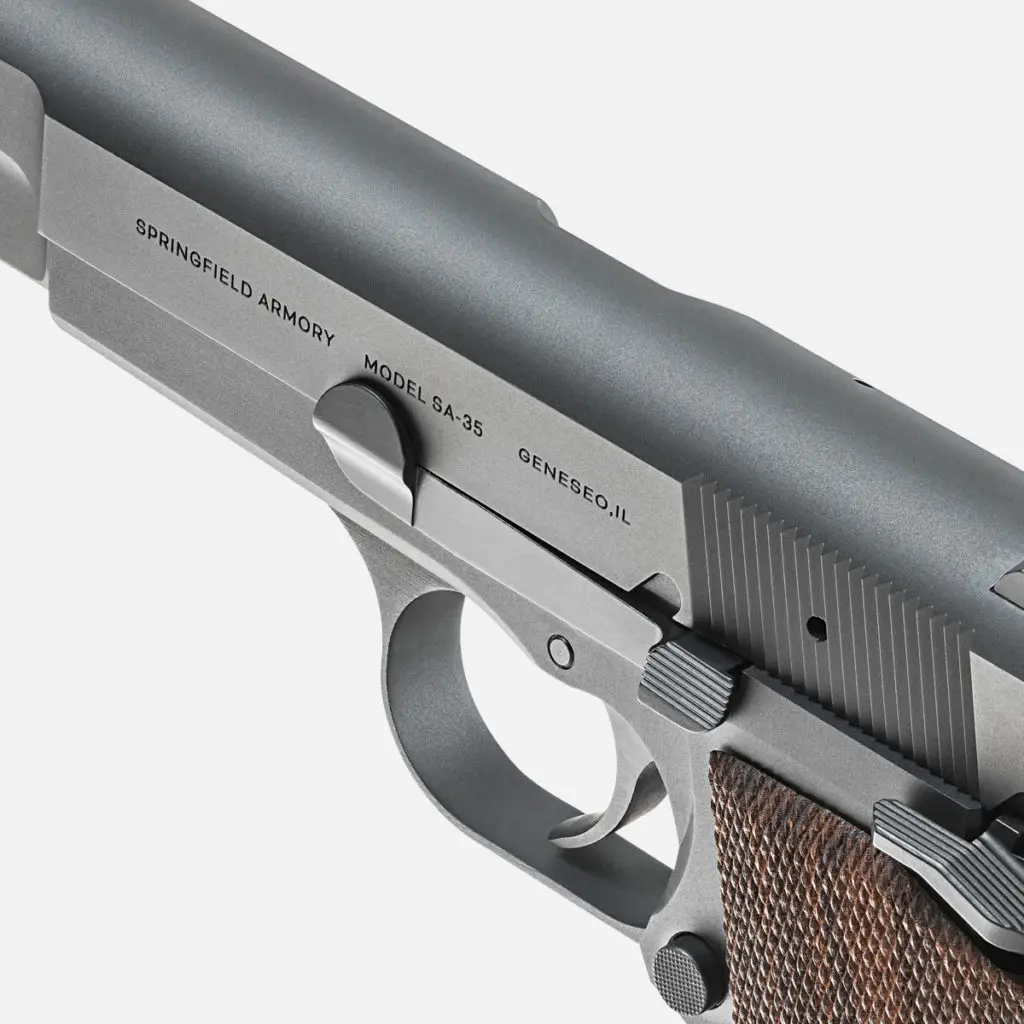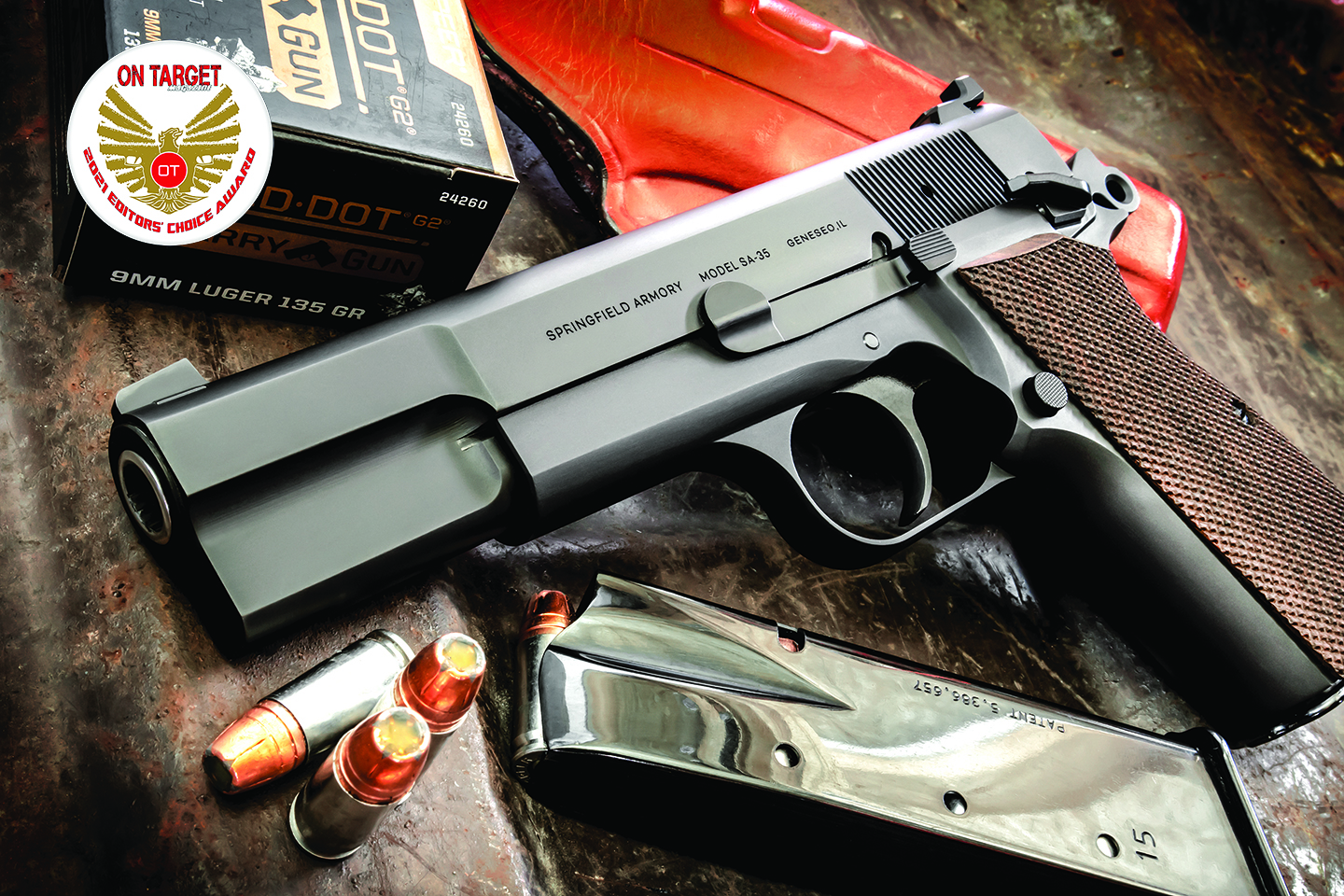Springfield Sa-35 Availability - The new Springfield Armory SA-35 is instantly recognizable as one of the most iconic handguns in history. The P-35, otherwise known as the Browning Hi-Power was based on a design by John Browning, completed by FN in Belgium after Browning's death and released in 1935. When most people think of World War II handguns, they think of the 1911 and the Walther P-38, but the P-35 was already in the picture and used by the Allies and forces during the war. The design enjoyed great success in the following decades, with many countries using it in police and military applications.
With the introduction of the SA-35, Springfield Armory's goal was to produce an authentic version of the P-35, but with a few upgrades to help fit the needs of today's shooter. What they have come up with is a simple, clean, efficient gun that improves both the utility and assets of the P-35.
Springfield Sa-35 Availability

The SA-35 is not electronic. Compared to many previous iterations and adaptations of the P-35, it is modest in appearance. It's obviously a P-35, with a forged carbon steel frame and a well-machined slide finished in an almost Parkerized matte blue.
Review: 1k Rounds With The Springfield Sa 35 Hi Power :: Guns.com
It is filled with a modern low profile look. The front is a white dot and the back is a jagged "U" notch. The cap is adjustable for airflow and is secured with a set screw. Firmly pressed barrel bushing, uniform barrel fit with enough clearance for the barrel to drop during cycling, and unlike some semi-autos, pulling the slide with the hammer down is a smooth, even motion. Some guns take too much force to engage the hammer and keep it moving, and that makes for a stronger cocking motion and probably doesn't help with smooth cycling either.
The SA-35 has a safety arm on the right that doubles as a drop handle as in previous models. There is no de-cocker like some period-style guns, but there is a half-cock system. There is also an externally visible spoiler, something that was not on the original P-35 but was done on later models.
The slim textured walnut grips are almost fully checkered and help give the gun a nostalgic metal and wood look as well as practical comfort and utility. Under the hood, the SA-35's magazine—it comes with just one—holds 15 rounds of 9mm compared to the original P-35's 13 rounds. I noticed very little play between the slider and frame when in battery, but that's what I would have thought anyway. On the surface, it's a gun with clean lines, precision and finish, comfortable ergonomics, and a price for utility.
Among the reasons I think this new take on shooting will be successful are the many upgrades Springfield Armory incorporated into the design. Major upgrades include the elimination of the magazine disconnect, a better designed feed ramp, and a redesigned hammer. It also adds a slimmer, better grip, modern look and increased magazine capacity. The upgrades work with what's good about the P-35, but bring it up to a level that meets the expectations of today's gunners.
Springfield Armory Sa 35,browning High Power Hp,regent Br 9 Grips
The most significant difference between the SA-35 and earlier versions of the P-35 or Hi-Power is that Springfield decided to eliminate the magazine attachment. This feature does three things, none of which are desirable in today's handgun. First, he would not allow the gun to be fired without a magazine in it. Second, it does not allow the magazine to fall freely when the magazine release button is pressed. Shooters must have a free magazine pull. I'm sure this was originally intended as a safety feature and would probably prevent the magazine from being lost or the gun being accidentally discharged. Finally, and unfortunately, the magazine tie-in tends to make the trigger rough, harsh, and inconsistent to pull.
Eliminating the magazine disconnect is the best thing Springfield could have done to bring the SA-35 up to speed with other modern pistols.
The fit, feel and performance of the original P-35 and its variants are part of what made it successful in the first place, but there is always room for improvement. The forged steel frame and slide are P-35, but the interior of the mag is slightly beveled and has a thin checkered walnut stock. They are comfortable, functional and elegant. While their overall size isn't much different from other P-35 grips, their smooth taper eliminates hard corners and makes them more comfortable than some of the older square grips.

A common complaint with the P-35 is hammer bite, where the hammer presses the gunner's hand web against the barrel as it returns to its rearmost position. The SA-35 still has a rounded characteristic curve, but Springfield has modified the design to eliminate the gap between the tang and the hammer in the curved position and reduce the possibility of that painful impact.
Springfield Sa 35 9mm [r List]
The power ramp has also been reactivated. First, the gun will likely run on 124-grain ball ammo. With many modern hollowpoints and other defensive weapons in use today, it is not uncommon for older feed ramps to have trouble driving these loads. A feed ramp designed to work with most modern firearms is a great update to this barrel. The P-35 originally had a feed ramp called a "dorsal" It started at a very high and even vertical angle and then "huged" to more than a 45 degree angle up into the chamber. "Grabbed" feed ramps create a surface that can sometimes trap blanks as they exit the magazine, causing a delay in failure to record. The SA-35's long power ramp has a wide channel and no change in angle.
In testing the SA-35, I fired about 250 rounds of various types of 9mm ammunition. Bullets vary between 115, 124, and 147 grains, and I have shot many FMJ loads, mixed brass handloads, Remington UMC, Federal Syntech, and defensive loads like Federal HST and Hydra Shok. , Black-Hills Honey Badger , Winchester USA Ready Defense, Browning X-Point and Hornady XTP hollow point. I primarily shoot USPSA target sights from 9 to 50 feet, with some guns supported at 50 feet.
Best for range testing is something like a Springfield Armory SA-35, I would have an original P-35 or Hi-Power to compare it to. Although I have shot them before, I haven't. Instead, as I put the SA-35 through its paces, I switched to shooting the gun I currently carry, the P35 (p), better known as the VIS 35 or simply the Radom. Introduced in 1935, the same year as the P-35 or Hi-Power, it was a Polish-designed 9mm and replica of the pre-production version of the P-35 that added some 1911 stock. Not comparing apples to apples, but they share many key design similarities and some parts are identical. After getting one that my grandfather brought back from WWII, I found it to be such an interesting gun that I had to hunt down another one to use and carry. The VIS 35 I have was produced under the Nazi occupation and instead of the original P-35 it provides a good reference point with a very similar design.
The author's World War II Springfield SA-35 and VIS 35, a design that copies many of the original P-35 features. Tyler Friel
Several Articles On Springfield's New Sa 35
With adjustable adjustments, the Springfield Armory SA-35 is a comfortable pistol to hold and shoot. At the widest point of the handle, it is 1.32 inches wide. It's identical in size to my VIS 35 plastic grips, but with almost twice the strength and a shorter frame from front to back. My only point of concern was the left corner of the tang as it slid to allow my thumb to ride the safety. There is enough edge to be noticeable compared to the full tension of my VIS 35, but I haven't found it to be detrimental to my shooting, nor have I experienced hammer bite (which I had with my VIS 35) . I found the SA-35 to be a smooth draw with a smooth, controlled recoil curve - much sweeter than my VIS.
Springfield's wide channel, ramp improvement seems to do the trick for reliability, as in 250 rounds of most modern hollow point and other defensive ammunition, I have not experienced a single misfire. The feed ramp may seem like a moot point, but I can totally understand how an older style ramp could cause feeding issues with many modern defensive loads. It certainly was with my VIS 35. The feeds for my grandfather's VIS 35 empty beautifully, but I noticed right away that they would stay at the bottom of the feed ramp in the VIS 35 I bought. My grandfather's barrel was fully motorized with a top-down feed ramp, but the second feed ramp on the barrel was almost absent, creating a design similar to the "humped" feed ramp on early P-35s and a face that would plant all hollow. Careful file work and polishing takes care of the reliability issue, but the factory ramp feed in the Springfield SA-35 is superior in
Casio sa 35 manual, sa-35, m1 garand sa springfield, casio sa 35, springfield sa xd 9, casio sa 35 keyboard, springfield sa xd 45, springfield sa, springfield sa xd, springfield armory sa xd, paradigm sa-35, casio sa 35 price
0 Comments